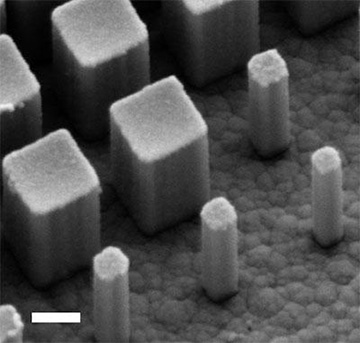
A scanning electron microscope image shows a side-view of the metalens, with nanopillars optimized to focus colors without chromatic dispersion. Scale bar: 200 nm. [Image: Courtesy of the Capasso Lab/Havard SEAS]
Building on previous work, a team of researchers at Harvard University, USA, led by OSA Fellow Federico Capasso, have designed a flat, achromatic metalens that can focus light while correcting for chromatic aberration across a sizable chunk of the visible spectrum (Nano Lett., doi: 10.1021/acs.nanolett.6b05137). The bandwidth covered by the lens is, according to the researchers, “close to that of an LED.” In the team’s view, the ability to engineer dispersion control across that bandwidth, in an ultraflat lens, could open new applications in imaging, spectroscopy and sensing.
Nubby surface
The Harvard researchers built upon previous research published last year in the journal Science (doi: 10.1126/science.aaf6644). In that work, they created metasurfaces dotted with titanium-oxide nanopillars that could act as ultrathin lenses in the visible band. Built with conventional lithography techniques and, thus, potentially scalable to high-throughput production, the metalenses pointed to a new generation of flat, space-efficient lens components with applications in smartphones, microscopes and other devices.
But there was one drawback: the metalenses still exhibited chromatic aberrations—differences in refraction for different wavelengths of light. And, while chromatic aberration can be easily handled in conventional refractive lenses (by adding additional macroscopic lenses and optical elements), it’s much tougher to address in the diffractive-optics world of flat metalenses.
Tweaking the nanopillars
To tackle the issue, the Harvard team began with some detailed numerical modeling of the TiO2 nanopillars used as the main building block in the metalenses. In particular, they tweaked the model parameters, including the nanopillars’ cross-sectional shape, width, center-to-center distance, and height, to maximize the phase coverage of the surface—and, at the same time, to allow guided-mode resonances that would allow for dispersion control at visible wavelengths. The researchers then fed the parameters into their fabrication process to create a prototype metalens.
The result, according to the team’s report, was a flat, achromatic lens with numerical aperture of 0.2, which could focus light continuously across a range of wavelengths from 490 nm to 550 nm without chromatic dispersion. As an additional demonstration of the ability to engineer dispersion characteristics into the metalenses, the team created a second metalens that featured reverse chromatic dispersion—that is, in which the focal length increased with the wavelength of the light.
New applications
The researchers note that the 490-nm-to-550-nm bandwidth of the flat metalens is “close to that of an LED,” a characteristic that, they suggest, could open the metalenses up to “a wide variety of applications that were not previously possible.” In particular, the team envisions leveraging the flat lenses to use in “imaging under LED illumination, fluorescence, and photoluminescence spectroscopy,” for which the illumination source or signal has a broader bandwidth than could be handled with previous metalens designs that couldn’t control chromatic aberrations.
One obvious first place for an application could be in reducing the bulk and complexity of some existing devices. “Traditional lenses for microscopes and cameras—including those in cell phones and laptops—require multiple curved lenses to correct chromatic aberrations, which adds weight, thickness and complexity,” Capasso noted in a press release. “Our new breakthrough flat metalens has built-in chromatic aberrations corrections so that a single lens is required.”
“By harnessing chromatic aspects, we can have even more control over the light," added the paper’s first author, Reza Khorasaninejad, a research associate in Capasso’s lab. With the ability to fine-tune the dispersion characteristics of the metalenses, Khorasaninejad suggests, “we showed that one can break away from the constraints of conventional optics, offering new opportunities only bound by the designer's imagination.”
